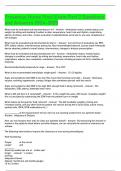Fresenius Nurse Final Exam Part 2 Questions
and Answers 2024-2025
What must be evaluated and documented pre-tx? - Answer: Ambulation status, mental status, pre-
weight, bp sitting and standing if patient is able, temperature, heart rate and rhythm, respirations,
edema, GI status, skin color, access evaluation, hospitalizations since last tx, any new complaints or
life changes
What must be evaluated and documented during tx? - Answer: Current time of evaluation, bp, BFR,
DFR, safety checks, arterial/venous pressures, fluid removed/administered, access check-hemosafe
device attached, patient's overall status, interventions, changes in dialysis presecription
What must be evaluated and documented post-tx? - Answer: Ambulation status, mental status,
changes in condition, post weight, bp sitting and standing, temperature, heart rate and rhythm,
respirations, edema, new complaints, evaluation of access including presence of thrill, condition of
dressing
Recommended body temperature range - Answer: 96.4-98.9
What is the recommended interdialytic weight gain? - Answer: 1.5-2.0 kg/day
Signs and symptoms that EDW is too low (Too much fluid is being removed): - Answer: Dizziness,
nausea, vomiting, hypotension, cramps, fatigue that sometimes persist until the next tx
Signs and symptoms that EDW is too high (Not enough fluid is being removed): - Answer: Htn,
headaches, SOB, edema, distended neck veins
What is AW and how is it calculated? - Answer: In the weight loss plan, AW means "available weight",
this is calculated by subtracting the EDW from the patient's pre-tx weight
What makes up the goal for fluid removal? - Answer: The AW (available weight), priming and
rinseback saline, and any other fluid the patient will receive during the tx (oral fluids, saline rinses,
packed cells, IDPN, IVPB medications etc. )
is the measurement of how well we are cleaning wastes from our patients' blood -
Answer: Adequacy of Dialysis
How can we measure how well we clean our patients' blood? - Answer: By measuring the amount of
wastes in the patient's blood before and after dialysis, we can calculate the amount of clearance we
achieve.
The following interventions improve the clearance of urea during hemodialysis:
Well functioning
Proper of the circuit
Larger and
Ensuring needle tips are at inches aprt
longer - Answer: 1. access
priming
dialysate & blood
dialyzer membrane and needle gauges
1.5 to 2 inches
, tx times
What are 2 consequences of improperly primed dialyzer? - Answer: 1. When the of fibers available to
affect clearance is greatly reduced, the result is a less effective tx for the patient.
2. Clotted fibers/ dialyzer will also result in a certain amount of blood loss for the patient, resulting in
a potential for reduced hgb level.
What is considered the best method currently available for determining tx effectiveness and is
mandatory in all FMC clinics? - Answer: UKM (Urea Kinetic Modeling)
In addition to UKM, these are two other methods of determining adequacy. - Answer: kt/V and URR
Why is measuring the adequacy of the dialysis tx so important? - Answer: When the tx is more
effective, patients live longer and have fewer health problems.
What does Kt/v stand for? - Answer: K stands for the clearance (think k sound) of urea, t is the time in
minutes, and v is the total volume of waste (urea) that exist in the patient
What is the difference between spKt/v and eKt/v and how is it determined? - Answer:
~single pool or spKt/v is the amount of dialysis having been delivered upon completion of the HD tx,
it's the reduction from one pool of fluid (vascular space)
~double pool or eKt/v is the measured amount of dialysis accounting for the volume of urea
distribution in both intracellular and extracellular compartments representing the amount of urea
distribution of the entire body.
What is FMCNA's goal for spKt/v and eKt/v? - Answer: Minimum 1.4 L for spKt/v and
1.2 L for eKt/v
OLC stands for - Answer: On Line Clearance
T machines are equipped with technology that that can measure single pool Kt/v. OLC test measure
transfer across the dialysis membrane which serves as a substitute for urea, so it's removal
reflects how urea is removed. - Answer: Sodium
These lights on the HD machines provide a visual indicator for tx adequacy. - Answer: AMP
KECN is the acronym for and refers to the clearance of sodium as measured by the
conductivity changes during the OLC test. - Answer: clearance effective by conductivity sodium
KECN normal range is - Answer: 200-300
KCEN should be less than - Answer: The BFR
Less than KECN is poor clearance and will not be used by Proton to generate and OLC
Volume - Answer: 150
Greater than KECN indicates that the machine may potentially need temp and conductivity calibrated
- Answer: 350
How many KECN tests can be programmed into OLC? - Answer: Between 3-6 test/ If a tx is 3-4 hours
in length, 6 tests should be programmed.
How long should blood tubes spin? - Answer: Spin blood specimens for 10 minutes
What lab tubes should not be spun in the centrifuge? - Answer: Collection tubes containing
anticoagulants




